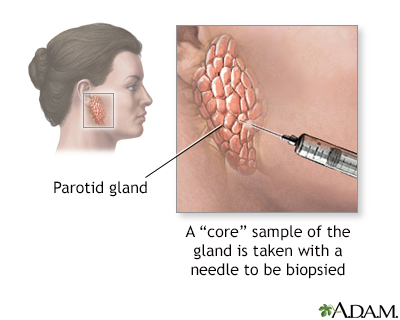
Biopsy - salivary gland
Salivary gland biopsy is the removal of cells or a piece of tissue from a salivary gland for exam.

You have several pairs of salivary glands that drain into your mouth:
One type of salivary gland biopsy is a needle biopsy.
A biopsy can also be done to:
An open surgical biopsy of the minor salivary glands in the lips or the parotid gland can also be performed to diagnose diseases such as Sjögren syndrome.
There is no special preparation for a needle biopsy. However, you may be asked not to drink or eat anything for a few hours before the test.
For surgical removal of a tumor, preparation is the same as for any major surgery. You will not be able to eat anything for 6 to 8 hours before the surgery.
With a needle biopsy, you may feel some stinging or burning if a local numbing medicine is injected.
You may feel pressure or mild discomfort when the needle is inserted. This should only last for 1 or 2 minutes.
The area may feel tender or be bruised for a few days after the biopsy.
The biopsy for Sjögren syndrome requires an injection of the anesthetic in the lip or in the front of the ear. You will have stitches where the tissue sample was removed.
This test is done to find the cause of abnormal lumps or growths of the salivary glands. It is also done to diagnose Sjögren syndrome.
The salivary gland tissue is normal.
Abnormal results may indicate:
Risks from this procedure include:
Miloro M, Kolokythas A. Diagnosis and management of salivary gland disorders. In: Hupp JR, Ellis E, Tucker MR, eds. Contemporary Oral and Maxillofacial Surgery. 7th ed. Philadelphia, PA: Elsevier; 2019:chap 21.
Orlowski HLP, Miller-Thomas M. Diagnostic imaging and fine-needle aspiration of the salivary glands. In: Flint PW, Francis HW, Haughey BH, et al, eds. Cummings Otolaryngology: Head and Neck Surgery. 7th ed. Philadelphia, PA: Elsevier; 2021:chap 82.
BACK TO TOPReview Date: 1/29/2025
Reviewed By: Ashutosh Kacker, MD, FACS, Professor of Clinical Otolaryngology, Weill Cornell Medical College, and Attending Otolaryngologist, New York-Presbyterian Hospital, New York, NY. Review provided by VeriMed Healthcare Network. Also reviewed by David C. Dugdale, MD, Medical Director, Brenda Conaway, Editorial Director, and the A.D.A.M. Editorial team.

|
A.D.A.M., Inc. is accredited by URAC, also known as the American Accreditation HealthCare Commission (www.urac.org). URAC's accreditation program is an independent audit to verify that A.D.A.M. follows rigorous standards of quality and accountability. A.D.A.M. is among the first to achieve this important distinction for online health information and services. Learn more about A.D.A.M.'s editorial policy, editorial process and privacy policy. A.D.A.M. is also a founding member of Hi-Ethics and subscribes to the principles of the Health on the Net Foundation (www.hon.ch). |
The information provided herein should not be used during any medical emergency or for the diagnosis or treatment of any medical condition. A licensed medical professional should be consulted for diagnosis and treatment of any and all medical conditions. Call 911 for all medical emergencies. Links to other sites are provided for information only -- they do not constitute endorsements of those other sites. © 1997- A.D.A.M., Inc. Any duplication or distribution of the information contained herein is strictly prohibited.